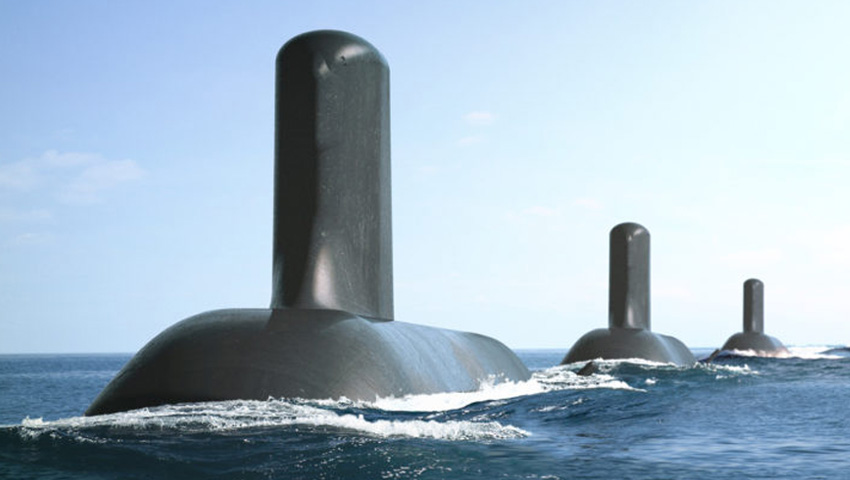Lockheed Martin Australia has announced the award of eight contracts to Australian industry and academic organisations for a combined value of $600,000 to author white papers on the development of novel and emerging advanced technologies in support of Australia’s Attack Class submarine combat systems.
To continue reading the rest of this article, please log in.
Create free account to get unlimited news articles and more!
This is the second cycle of research and development (R&D), which is funded under the Future Submarine Combat System Integrator Program. The R&D program is based on an ongoing nine-month cyclic process funded by the Commonwealth and administered under the Lockheed Martin Australia contract.
Each R&D cycle consists of proposals from industry and academia against a set of published R&D topics.
After a competitive review and assessment of proposal responses, down-selected responses are awarded a contract to fund further development of a White Paper. Upon completion of the white papers, further contracts may be awarded to selected respondents for ongoing capability research.
The combat system R&D program features a continuous process to build ongoing Australian combat system R&D capabilities that have been scaled to meet the long-term needs and developing future capability and technology for the Australian Submarine Force.
Joe North, chief executive Lockheed Martin Australia and New Zealand, said the company looked forward to working with the successful organisations to develop and deliver world-class innovative technologies for Australia’s Attack Class submarines.
"The Attack Class Submarine Program represents a long-term, multimillion-dollar investment in the future defence and security of our nation. Today’s announcement is another step towards ensuring Australia has the technology and skills to deliver and maintain a regionally superior submarine fleet," North said.
The program includes a defined approach for transition of successful R&D outcomes into the evolving Attack Class combat system baseline configurations. To date, two R&D cycles are currently underway with a third cycle commencing later this month.
Industry partner and managing director of Airspeed Steve Barlow said he is pleased to be working on the R&D component of the program in support of Lockheed Martin Australia and the Commonwealth following his company’s award of a contract under the second R&D cycle.
"The Airspeed team is excited by this opportunity to deliver a paper on the suitability and benefits of advanced materials for the Attack Class combat system. We are delighted to be working with Lockheed Martin Australia in a collaborative environment with the potential to provide real-world outcomes for the program," Barlow said.
The first cycle of R&D contracts in March 2019 saw more than $900,000 allocated to industry and academic institutions for white paper development. These cycle one white papers are currently being assessed for suitability for the competitive award of contracts for longer-term ongoing capability research.
Requests for the following topics under cycle two projects were sought and the organisations that have been successful for the award of contracts of $75,000 each are shown against each topic:
- Novel methods for reliable communications on an unstable platform - contract awarded to Innovations for Humanity from NSW;
- Emerging technologies for improved autonomous celestial navigation - contract awarded to University of Adelaide;
- Distributed underwater sensor networks and their impact on submarine operations - no contracts were awarded under this topic for cycle two;
- Novel methods to integrate compressive sensing techniques - contract awarded to University of South Australia;
- Novel methods to monitor, track and efficiently manage power within racks - contract awarded to University of Melbourne;
- Use of advanced materials and fabrication processes to overcome space, weight, power and cooling constraints - contract awarded to Airspeed Pty Ltd located in South Australia;
- Investigation into real-time monitoring of human performance - contract awarded to University of South Australia;
- Smart driven dynamic reallocation of computing resources based on compute demands - two contracts were awarded under this topic to University of Tasmania and IPACS Australia located in South Australia.
North added, "Lockheed Martin Australia, in concert with the Department of Defence, is proud to be creating genuine R&D opportunities for industry and academia to develop enhanced and innovative combat system capabilities."
The Attack Class submarines will be delivered as part of the $50 billion SEA 1000 Future Submarine program. Naval Group will build 12 regionally superior submarines to the Royal Australian Navy.
Lockheed Martin will provide the AN/BYG-1 combat control system, which provides an open-architecture submarine combat control system for analysing and tracking submarine and surface-ship contacts, providing situational awareness as well as the capability to target and employ torpedoes and missiles.
The 12 vessels will be built by Naval Group at a specialist submarine shipyard at Osborne, South Australia. The Commonwealth government’s Australian Naval Infrastructure (ANI) program will support the development of the future submarine shipyards.
The Commonwealth government formally signed the strategic partnering agreement (SPA) with Naval Group in February 2019 ahead of confirming the final design specifications and requirements for the Attack Class submarines.
The Attack Class will enter service with the RAN at a time when 50 per cent of the world’s submarines will be operating in the Indo-Pacific region.

 Login
Login







